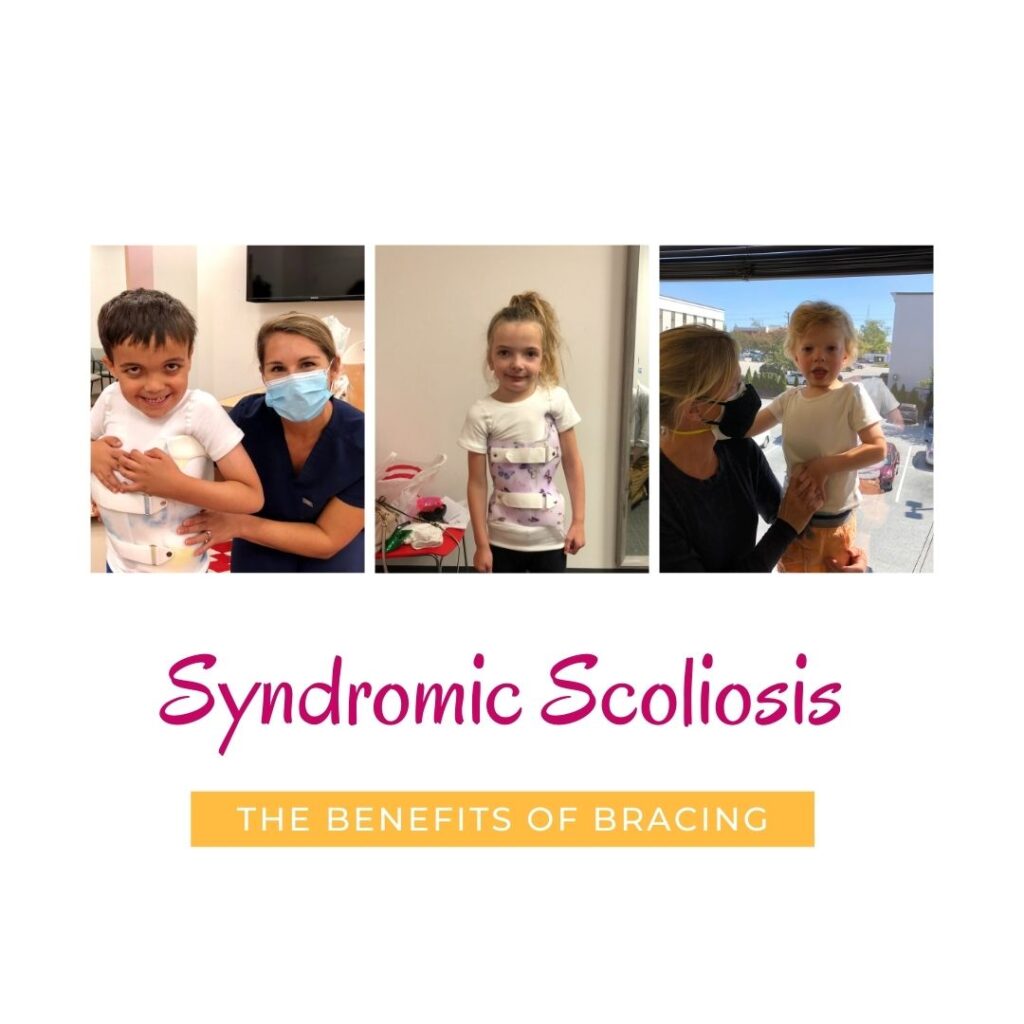Most scoliosis cases are idiopathic, indicating that the spinal curvature occurs spontaneously and with an unknown cause. Idiopathic scoliosis is generally diagnosed in children 10-15 years old. Although they are less prevalent, there are also cases of syndromic scoliosis where the spinal curvature arises from an underlying condition (either genetic or non-genetic). Syndromic scoliosis is most often discovered in early childhood.
There are several syndromes, which when diagnosed in very young children, will alert doctors to the increased possibility of scoliosis. The severity of curvatures in syndromic scoliosis will vary greatly depending on the particularities of the specific causal condition.
Some of the most common syndromes associated with this type of scoliosis are those that affect connective tissues, including Marfan and Ehlers-Danlos Syndromes. These are similar in that they are caused by defects in the gene responsible for producing the protein that gives the body’s tissues strength and elasticity (The Marfan Foundation, 2014).
Other syndromes that might feature a predisposition to scoliosis are those that are characterized by low muscle tone and physical developmental delays, including Xia-Gibbs, Prader-Willi, and Williams-Beuren Syndromes.
When any of these conditions are diagnosed, early screening for signs of scoliosis is recommended. Families and their medical teams should be on alert for the possibility that unchecked spinal curvatures could exacerbate existing challenges brought on by the specific syndrome (Scoliosis Research Society, 2020).
“The increased potential for scoliosis certainly makes it important that parents and doctors are diligent in monitoring the spinal health of children diagnosed with these conditions,” says Luke Stikeleather, Chief Orthotist at the National Scoliosis Center. “Early non-operative interventions can impede the progression of curvatures, helping young patients avoid a wide range of medical complications and invasive procedures.”
Due to rapid physical development in early childhood, curves can progress significantly in a short period of time. Mobility issues, heart and lung problems, and impaired breathing can occur if spinal curves are left untreated (Tobias M. Baulhause, 2019).
Most often the treatment protocols for syndromic scoliosis are similar to those put in place for idiopathic cases. X-rays and regular follow-up appointments to monitor any changes in the spine will be key. For cases where curves measure between 10 and 20 degrees, careful observation every three to four months is recommended.
If a curve worsens, advancing above 20 and up to 40 degrees, non-operative techniques like casting and bracing are favorable options.
Casting may be necessary as a precursor to bracing for very young children as their small stature and age may make compliance with wearing a brace challenging. Casts are made from lightweight material and can help guide spine growth. They cannot be removed on a day to day basis, but they will be changed regularly – generally every 2-3 months – as the child grows (Scoliosis Association UK, 2020).
Eventually, a brace will be more comfortable for the maturing child. The goal of bracing is to help slow curve progression while still allowing proper physical development. In turn, this will help to maximize optimal organ function, lung capacity, and mobility, as well as prevent the need for surgery.
As in the case of idiopathic scoliosis, the effectiveness of bracing in syndromic scoliosis will be heavily influenced by the patient’s compliance with wearing the brace for the prescribed number of hours. It is typically recommended that patients wear the brace for up to 20 hours per day.
The innovative Rigo Cheneau brace has proven an ideal option. This type of brace addresses the 3D nature of scoliosis and has shown marked success in impeding curve progression.
National Scoliosis Center uses state of the art technology to construct the Rigo Cheneau brace so that it is uniquely tailored to fit each patient. Composed of thin, lightweight plastic, it works by applying force to specific points to decrease curves and rotation. Compression and breathing spaces on each brace are unique to each patient.
All National Scoliosis Center’s orthotists are cognizant of the fact that constructing the most comfortable brace will create the greatest degree of patient compliance and therefore, successful treatment.
“We will add padding in certain areas to provide a more comfortable fit and will make sure the brace doesn’t put pressure on areas where it doesn’t need to,” says Certified Orthotist, Kristian Christensen. “We are committed to working closely with patients and their parents to address any areas of concern and make adjustments, as necessary.”
Parents of children diagnosed with any of these syndromes face a number of challenges when it comes to their children’s health. Fortunately, early detection of syndromic scoliosis allows medical teams to be persistent in monitoring the spinal health of these young patients so intervention can begin as early as possible. At National Scoliosis Center, our orthotists are committed to offering individualized care and attention to meet the unique needs of our patients with syndromic scoliosis. We are dedicated to working alongside children, parents, and other medical professionals to provide the most successful outcomes for spinal health and the overall quality of life for our patients.
